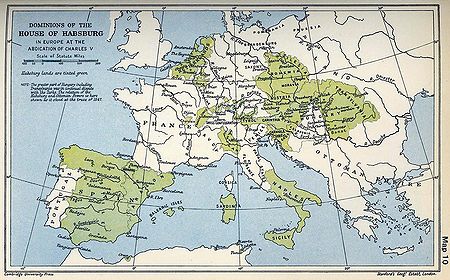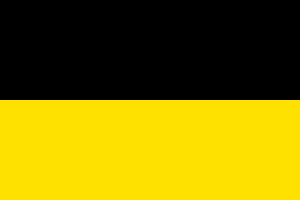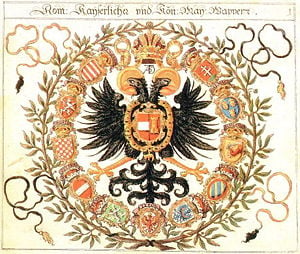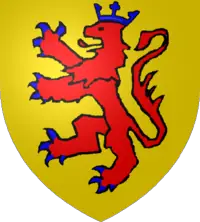Habsburg
Habsburg (in English speaking countries sometimes spelled Hapsburg, but never so in official use) was an important ruling house of Europe and is most well known to be the ruling House of Austria (and the Austrian Empire) for over six centuries. Through marriage, the family ruled approximately half of Europe. They were Holy Roman Emperors and one of the most powerful families in Europe. Loss of the Austro-Prussuian War of 1866 resulted in the Austria-Hungarian Empire losing to its rival, Prussia, in leading German re-unification. Some suggest that had Austria won this contest, German history may have developed along less militaristic lines. Austria-Hungary was more pluralist and towards the end of its existence had embarked on a democratization program. It was the assassination of the heir to the Austrian-Hungarian throne,Archduke Franz Ferdinand, that sparked off the events that led to World War I and to the demise of the Habsburg monarchy. Vienna, the elegant, artistic and intellectually creative capital of the Habsburg was twice besieged by the Turks ( 1529 and 1683). On the latter occassion, the Emperor fled from the city. and with custody of Bosnia Herzegovina from 1878 following the Berlin Conference the Empire represented for many a buffer-zone between East and West, the Christian and the Muslim worlds. Hungary had itself been part of the Ottoman Empire.
A brief history of the House of Habsburg
From Counts of Habsburg to Roman Emperors
The name is derived from the Swiss Habichtsburg (Hawk Castle), the family seat in the 11th, 12th and 13th centuries at Habsburg, Switzerland in the former duchy of Swabia in present-day Switzerland (Switzerland did not then exist in its present form, and the Swiss lands were part of the mainly Germanic Holy Roman Empire). From southwestern Germany (mainly Alsace, Breisgau, Aargau and Thurgau) the family extended its influence and holdings to the southeastern reaches of the Holy Roman Empire, roughly today's Austria (1278 - 1382). Within only two or three generations, the Habsburgs had managed to secure an initially intermittent grasp on the imperial throne that would last for centuries (1273 - 1291, 1298 - 1308, 1438 - 1740, and 1745 - 1806).
After the marriage of Maximilian I with Mary of Burgundy, heiress of Burgundy (the Low Countries) and the marriage of his son Philip I of Castile (known as Philipp the Handsome) with Joanna of Castile, heiress of Spain and its newly-founded empire, Charles V, Holy Roman Emperor inherited Spain, Southern Italy, Austria and the Low Countries. In 1580 his son Philip II inherited Portugal and its colonies, thus ruling over an empire where "the sun does not set".
Under Maximilian II, the Habsburgs first acquired the land upon which would later be erected the Schönbrunn Palace: the Habsburgs' summer palace in Vienna and one of the most enduring symbols of the dynasty.
Division of the House: Austrian and Spanish Habsburgs

After the April 21, 1521 assignment of the Austrian lands to Ferdinand I, Holy Roman Emperor from his brother Emperor Charles V, Holy Roman Emperor (also King Charles I of Spain) (1516 - 1556), the dynasty split into one Austrian and one Spanish branch. The Austrian Habsburgs held (after 1556) the title of Holy Roman Emperor, as well as the Habsburg Hereditary Lands and the Kingdoms of Bohemia and Hungary, while the Spanish Habsburgs ruled over the Spanish kingdoms, the Netherlands, the Habsburgs' Italian possessions, and, for a time, Portugal. Hungary, nominally under Habsburg kingship from 1526 but mostly under Ottoman Turkish occupation for 150 years, was reconquered in 1683 - 1699.
The Spanish Habsburgs died out in 1700 (prompting the War of the Spanish Succession), as did the Austrian Habsburgs in 1740 (prompting the War of the Austrian Succession). However, the heiress of the last Austrian Habsburg (Maria Theresa) had married Francis I, Holy Roman Emperor, Duke of Lorraine, (both of them were great-grandchildren of Habsburg Emperor Ferdinand III, but from different empresses) and their descendants carried on the Habsburg tradition from Vienna under the dynastic name Habsburg-Lorraine. It is often speculated that extensive intra-family marriages within both lines contributed to their extinctions, but there were few such marriages in the Austrian line. Smallpox killing young heirs was a greater cause.
House of Habsburg-Lorraine: the Austrian Empire
On August 6 1806 the Holy Roman Empire was dissolved under the French Emperor Napoleon Bonaparte's reorganisation of Germany. However, in anticipation of the loss of his title of Holy Roman Emperor, Francis II declared himself hereditary Emperor of Austria (as Francis I, thereof) on August 11, 1804, three months after Napoleon had declared himself Emperor of France on May 18, 1804.
Emperor Francis II of Austria used the official great title: "We, Francis the First, by the grace of God Emperor of Austria; King of Jerusalem, Hungary, Bohemia, Dalmatia, Croatia, Slavonia, Galicia (Central Europe), and Lodomeria; Archduke of Austria; Duke of Lorraine, Salzburg, Würzburg, Franconia, Styria, Carinthia, and Carniola; Grand Duke of Kraków; Grand Prince of Transylvania; Margrave of Moravia; Duke of Sandomir, Masovia, Lublin, Upper and Lower Silesia, Auschwitz and Zator, Teschen, and Friuli-Venezia Giulia; Prince of Berchtesgaden and Mergentheim; Princely Count of Habsburg, Gorizia, and Gradisca and of the Tyrol; and Margrave of Upper and Lower Lusatia and Istria]".
In 1867 effective autonomy was given to Hungary under the terms of the Ausgleich or "compromise" until the Habsburgs' deposition from both Austria and Hungary in 1918 following defeat in World War I.
The current head of the Habsburg family is Otto von Habsburg, Emperor Karl's eldest son.
Main Line
Before Rudolph I of Germany rose to become Holy Roman Emperor, the Habsburgs were Counts in what is today southwestern Germany and Switzerland.
Ancestors
- Guntram, Count of Habsburg (Guntram the Rich) (ca. 930 - 985 / 990) Father of:
- Lanzelin, Count of Habsburg (d. 991). Besides Radbot, he had sons named Rudolph I, Werner I, Bishop of Strasbourg, and Landolf.
Counts of Habsburg
- Radbot built the Habsburg castle (ca. 985 - 1035


